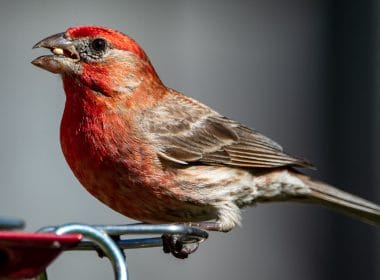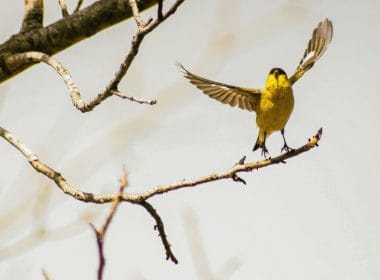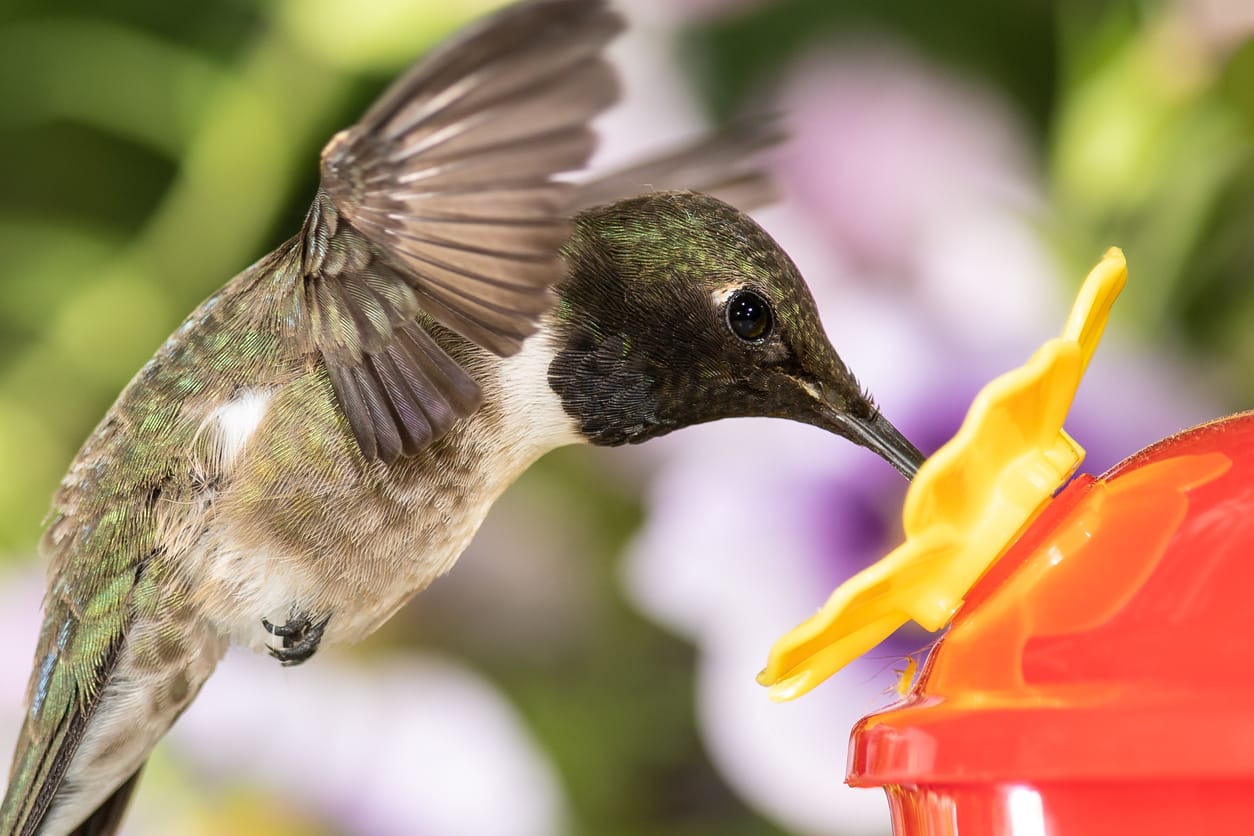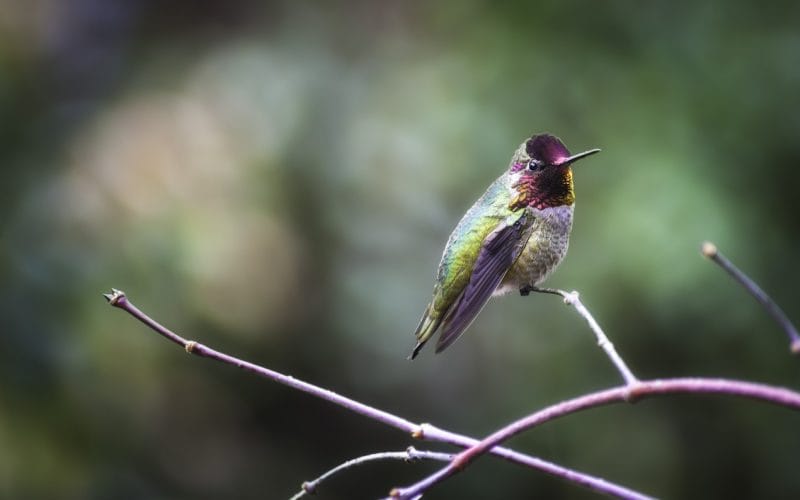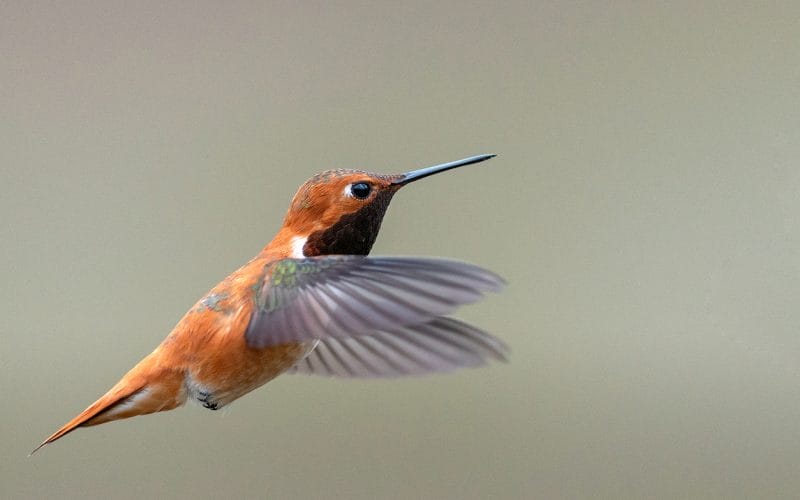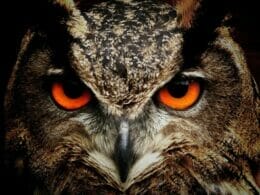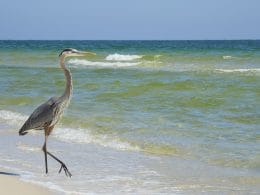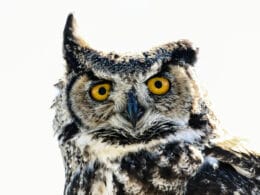There are over 360 species of the smallest birds in the world, hummingbirds. So every year, we get to discover new species of these amazing birds.
Don’t be fooled by their small sizes; hummingbirds are feisty and excellent flyers. They’re among the most skilled birds at flying, being the only species on earth than can fly backwards.
Hummingbirds can also flap their wings very fast. Depending on the species, they can flap their wings up to 80 beats per second.
It’s such a joy to sit and watch hummingbirds flying around looking for food in your backyard. So in this article, we’ll tell you all about the hummingbirds in Pennsylvania and where you can see them.
Let’s get started!
6 Beautiful Hummingbirds Species in Pennsylvania
Luckily for us, there are about 365 species of hummingbirds that live in the Americas. The US is the home of 15 of these species.
There are also about nine vagrant species that can be found occasionally in the US. In Pennsylvania, the Ruby-throated hummingbird and the Rufous hummingbird are the most common.
However, the other four species can accidentally find their way into the state. Here’s a list of the six hummingbird species in Pennsylvania.
1. Ruby-Throated Hummingbird
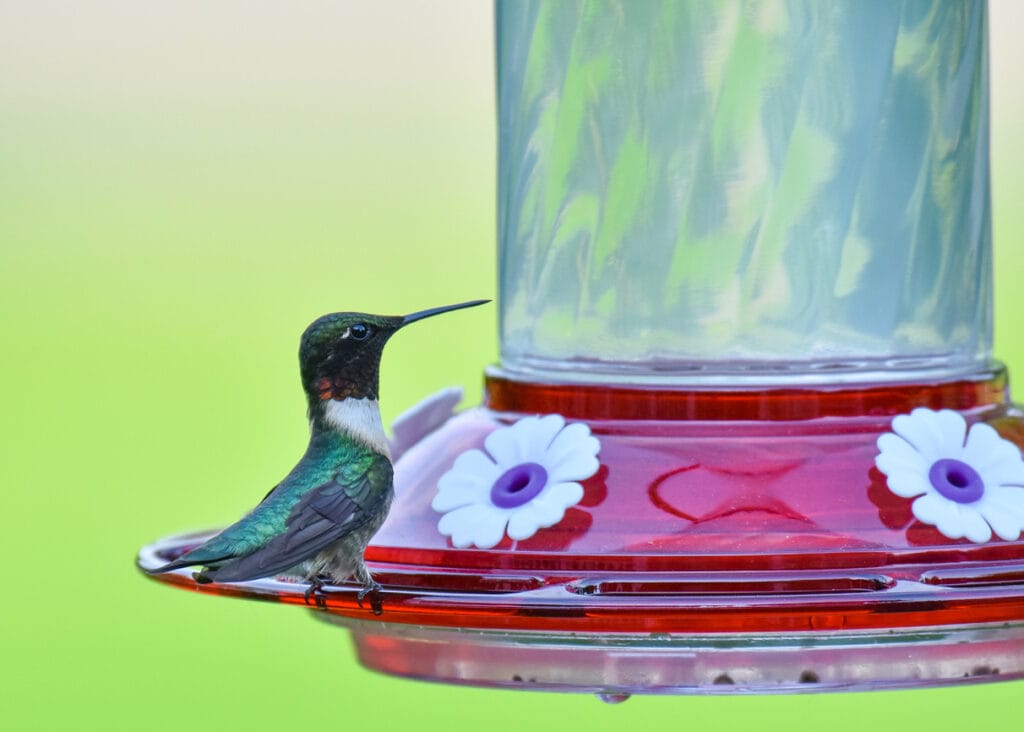
- Scientific Name: Archilochus colubris
- Length: 3 to 4 in
- Weight: 0.1 to 0.2 oz
- Wingspan: 3 to 4.5 in
The Ruby-throated Hummingbird is the most common in the US. Also, it’s the only breeding hummingbird in the eastern United States.
It only comes to the US and Canada during its breeding season in the summer. After that, it leaves its wintering home in the south and arrives in the eastern US around March.
Pennsylvania is one of the lucky states to have this hummingbird as its summer resident. It arrives in the southern parts of the state in late April.
For those who live in the northern parts of the state, you can start anticipating its arrival at the beginning of May. It stays in PA until late October.
Ruby-throated Hummingbirds are beautiful small birds. It’s easy to identify them with their beautifully colored plumage.
Their upper bodies and crown are emerald or golden-green, while their underparts are grayish. Males and females generally look the same except for one difference.
Males have ruby red throats that females lack, hence the name. They’re cute and all, but they have aggressive tendencies.
Author Note: They’re among the most agile flyers in the bird world. They can flap their wings of an average of 53 beats in one second and can fly up to 25 miles an hour.
These hummingbirds are territorial birds. They’ll put up a fight if they have to. They defend their territory fiercely against all kinds of potential enemies.
It’s common to see a breeding pair of these beautiful hummingbirds taking shelter in your backyard. So, make sure to put up a hummingbird feeder by April.
The diet of these colorful hummingbirds consists mainly of the nectar of tubular flowers and insects. Many of the flowers they feed on are red and orange.
That’s why many prefer to set up a feeder that is either red or orange. You can mix a quarter cup of sugar per one cup of water so they can feed on it.
2. Rufous Hummingbird
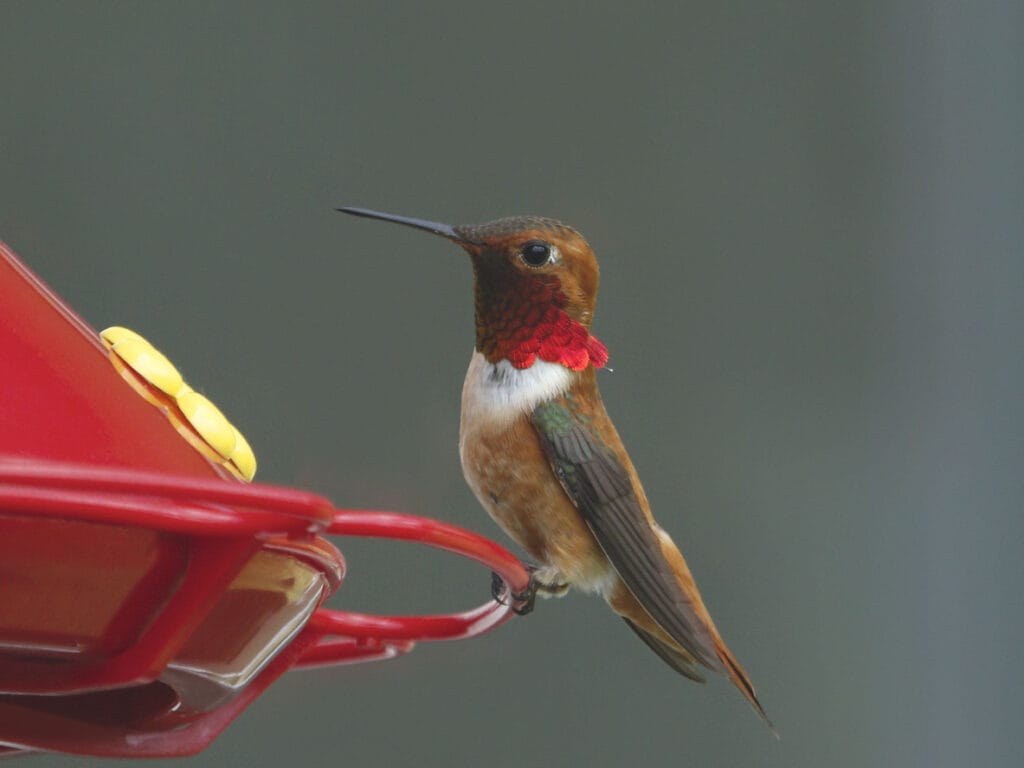
- Scientific Name: Selasphorus rufus
- Length: 2.8 to 3.75 in
- Weight: 0.1 to 0.2 oz
- Wingspan: 4 to 4.5 in
Rufous Hummingbirds aren’t as common in Pennsylvania as Ruby-throated hummingbirds. The birds tend to be more common in the western US.
However, they’re the second most sighted species of hummingbirds in the eastern US. A few of them wander off to Pennsylvania each year in fall or winter.
They arrive in early August and leave by April, making the state their winter home instead of migrating to their existing winter home in Mexico. The rest that does make it to Mexico have the longest migration journey in the bird world, as measured by body size.
These tiny hummingbirds migrate every year, taking a route of 3,900 miles from Alaska to Mexico. What makes it more impressive is that their migratory journey is one way.
In their wintering homes in Mexico, they live in shrubby openings and oak-pine forests. While in their breeding homes, they live in open areas, fields, yards, and forests.
From their name, you get that they have rufous plumage. However, that’s only the case with males.
Males glow like coals in bright sunlight. They have bright orange backs and bellies. They also have iridescent-red throats that differ in color from red to orange to green, depending on the light.
Females, on the other hand, have green upper bodies, rufous flanks, and a spot of orange on their throats. Juveniles look similar to females.
Although the Rufous Hummingbird is one of the smallest birds in the world, it’s one of the most aggressive hummingbirds in North America.
It cares mainly about its food and territory. Even more than breeding. It’ll fight and chase down any bird or animal that comes near its source of food.
So, you know that these hummingbirds will cause all sorts of trouble in your backyard if you put a feeder for them. However, it’s still lovely to have them in your backyard during winter.
They have a similar diet to Ruby-throated hummingbirds. Providing them with sugar water mixtures is ideal. Make sure to change the water regularly before it turns cloudy or discolored.
It’s also a good idea to leave some perches out for them. They like perching and watching their territory for any intruders.
3. Calliope Hummingbird

- Scientific Name: Selasphorus calliope
- Length: 2.7 to 3.9 in
- Weight: 0.1 oz
- Wingspan: 4 to 4.3 in
Calliope Hummingbirds don’t take the eastern US as their home. However, there are sightings of a few vagrant Calliope hummingbirds in Pennsylvania outside of their breeding season.
These tiny birds have one of the longest migration routes, covering 5000 miles from Mexico to the Pacific Coast every spring. They have the record for the smallest long-distance migrants.
The tiny bird is the smallest in North America. It weighs about the same as a ping pong ball.
However, it’s a feisty bird. It perches on higher willows and alder branches to observe and defend its territory. Also, it’s not scared to chase away larger birds like Red-tailed Hawks.
Think of how funny it is to watch one of the smallest birds in the world chasing the all-mighty Red-tailed Hawk away.
Calliope hummingbirds are extremely easy to identify. Their stand-out feature is their magenta throats, which are only found in males.
Top Tip: Male Calliope Hummingbirds have greenish upper bodies and underparts. Meanwhile, females and juveniles lack magenta throats and have peachy color on their undersides.
When a male Calliope wants to get the attention of a female, he performs U-shaped display dives that are pretty distinctive. His wingbeats and his tail feathers make a sound like a buzzing bee.
While it’s rare to find these beautiful hummingbirds in Pennsylvania, it’s more common to see them in the southeastern part of the state.
Look for them in open forests and scrubby edges. You can also attract them to your backyard by setting up a sugar-water feeder.
Avoid using food coloring. Also, adding flowers to your backyard will increase your chance to see these beautiful birds.
Fun fact, the Calliope Hummingbird was named after Calliope, the patron of epic poetry.
4. Black-Chinned Hummingbird
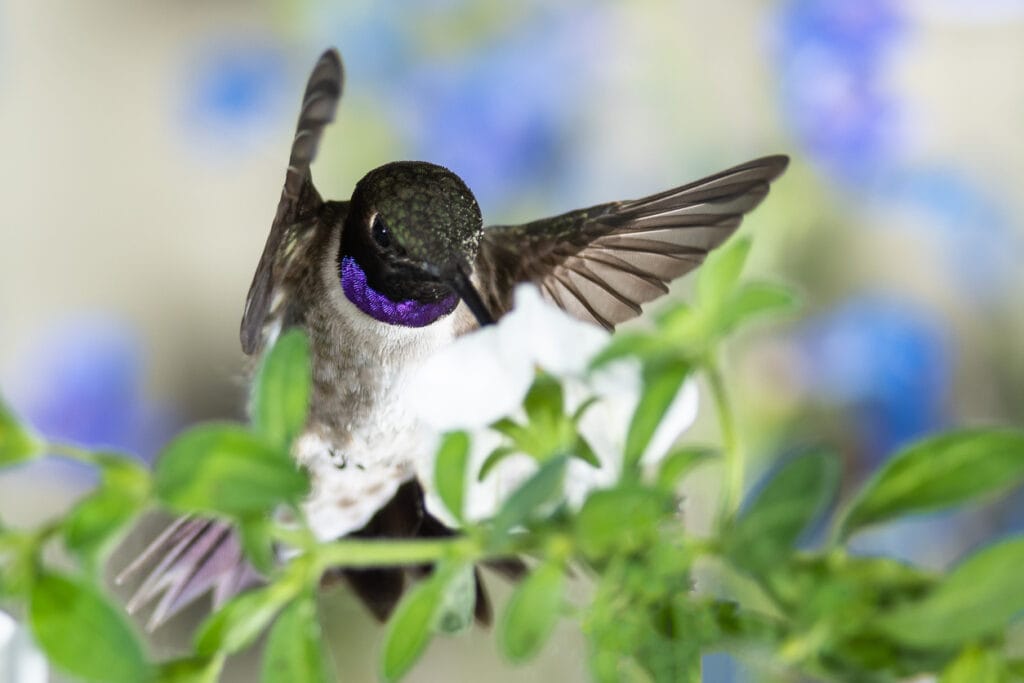
- Scientific Name: Archilochus alexandri
- Length: 3.5 in
- Weight: 0.1 to 0.2 oz
- Wingspan: 4.3 to 5 in
Similar to the Calliope Hummingbird, the Black-chinned Hummingbird is also rare in the state. It’s a breeding hummingbird of the western US.
However, there have been sightings of it on the east coast. During the migration season, a few Black-chinned Hummingbirds might stop temporarily in Pennsylvania or spend the winter there.
It’s understandable knowing that these hummingbirds are among the most adaptable hummingbirds in the world.
To increase your chance of seeing this beautiful hummingbird, make sure you provide sugar-water feeders and plenty of flowers for nectar. Black-chinned Hummingbirds feed mainly on nectar, especially in the summer.
Their tongues can extend through their bills at a rate of about 17 licks per second. They usually consume on average 0.61 ml in one meal.
Author Note: In winter, they can feed on three times their body weight in nectar in a single day. However, they can still live entirely on insects if there are plenty.
Black-chinned Hummingbirds have metallic green upper bodies with dull metallic green flanks. Males have black chins, hence the name.
They also have black throats with an iridescent purple band that only shows up in good lighting. Females have white throats with pale green streaking.
5. Allen’s Hummingbird
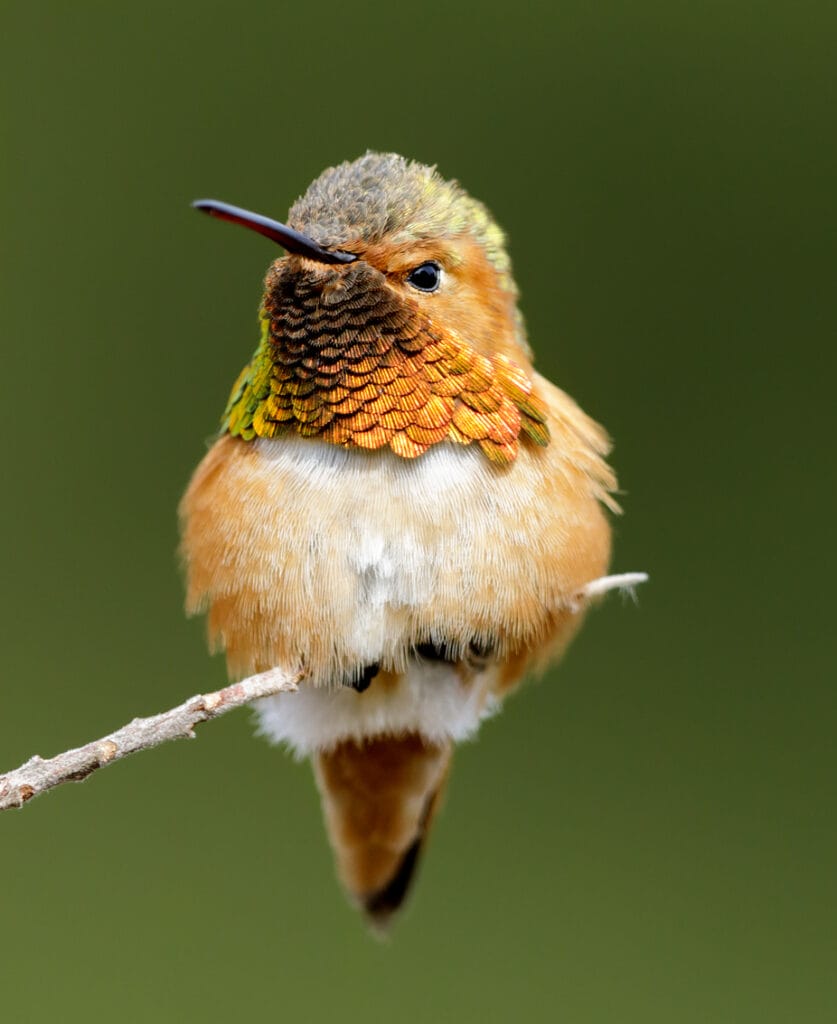
- Scientific Name: Selasphorus sasin
- Length: 3.5 to 3.75 in
- Weight: 0.1 oz
- Wingspan: 4.3 to 4.75 in
It’s easy to mistake these species with Rufous Hummingbirds. They look nearly identical.
The only way to tell them apart is by their tail shape. Allen’s Hummingbirds have tails that extend past their wings and a narrow outermost feather on their tails.
These tiny hummingbirds breed in California and coastal Oregon. In winter, one subspecies migrates to its wintering home in Mexico.
Meanwhile, another subspecies spend the winter in southern California and is a resident of the state all year round. A few vagrant Allen’s hummingbirds might spend a few days in Pennsylvania while on their way to Mexico.
So, there is a slight chance you might spot this bird in the keystone state. The Philadelphia and Lancaster area is the best place to spot this bird at.
If you live near this area, make sure to set up a hummingbird feeder or plant flowers to attract Allen’s Hummingbird.
Keep in mind that Allen’s are early migrants compared to other North American hummingbirds. They leave their wintering homes in December and arrive in January at their breeding destination.
A fun fact to know about this tiny bird is that it uses its feet to control its body temperature. This is something common in many other birds, but it’s odd to see it with hummingbirds, considering their tiny size.
It tucks its feet up against its belly when flying if the weather is cold and does the opposite in hot temperatures.
6. Anna’s Hummingbird
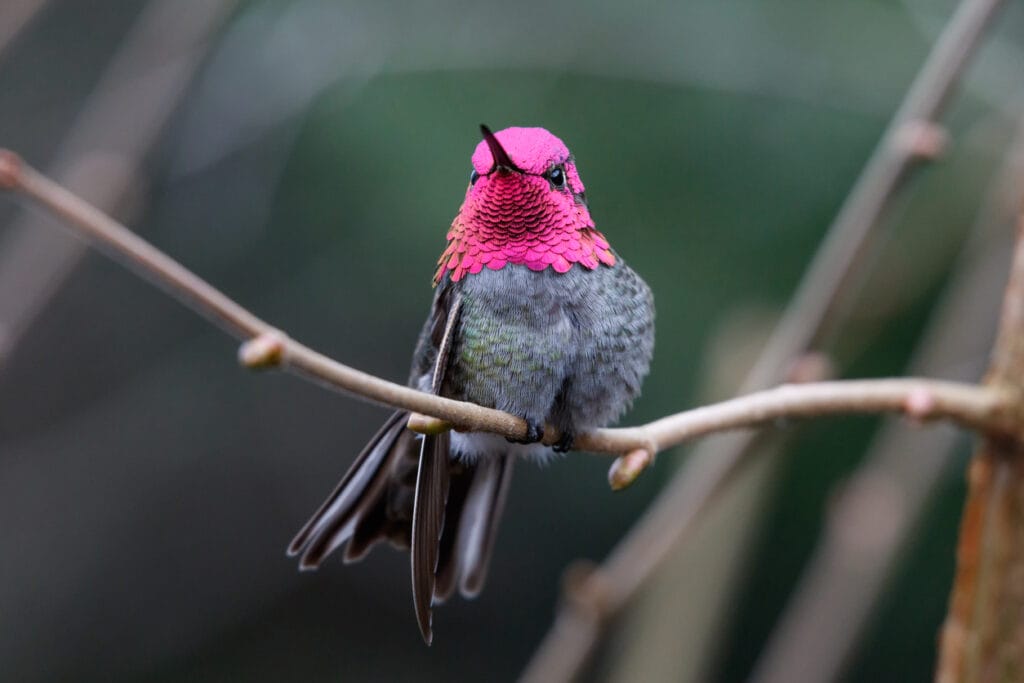
- Scientific Name: Calypte anna
- Length: 3.5 to 4 in
- Weight: 0.1 to 0.2 oz
- Wingspan: 4.7 in
This is another species that shows up accidentally in Pennsylvania. It shows up from time to time during the winter, especially in the southeastern parts of the state.
Anna’s Hummingbirds are the only ones that don’t migrate for long distances on this list. Some of them might migrate. However, they mostly stay in the same territory all year round. They’re the most common in the Western states and along the Pacific Coast.
The colors on this bird are absolutely magnificent. These hummingbirds have mostly green and gray plumage. Males have an iridescent reddish-pink gorget. Oddly, females have gorgets as well but way smaller.
Anna’s hummingbirds can’t handle the cold weather. So, they go into torpor, and when the temperature warms up, they become active within a few minutes. This is why their normal body temperature is about 107°F.
Author Note: These hummingbirds have one of the most interesting courtships. Males climb up to 130 ft high into the air and then swoop to the ground.
They make a noise with their tail feathers as well during the dive. The dive display takes about 12 seconds.
The Wrap Up
It’s always a joy to spot a hummingbird or have it visit your yard. They’re beautiful and interesting to watch.
There’s so much more to them despite their tiny sizes. Although Pennsylvania isn’t blessed with many species of hummingbirds, you can still attract a pair to your yard or spot one accidentally.
Next time you spot a hummingbird, you’ll know exactly which species it is.
FAQ
Backyards and gardens are the best place to see hummingbirds in Pennsylvania. Put up a feeder and see what happens.
The Ruby-throated Hummingbird is the most common species in Pennsylvania.
To find out where recent sightings of hummingbirds have been, try eBird. You can search for the latest sightings or particular species or what has been seen in a certain area.
